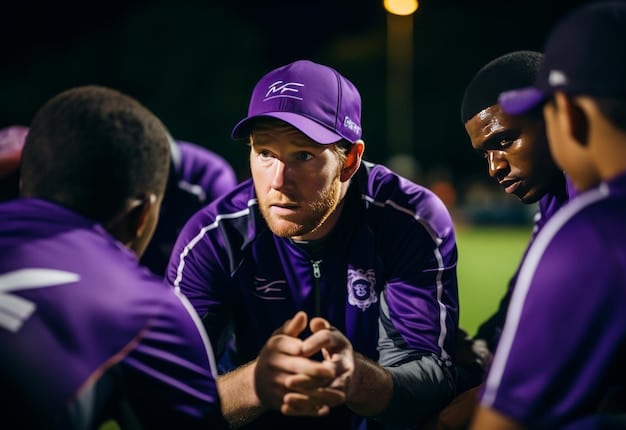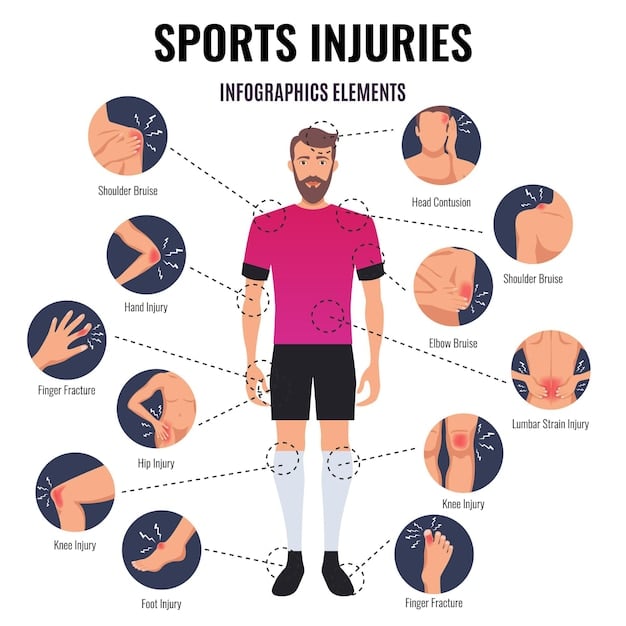King’s League Injury Report: Key Players Out & Return Timelines

King’s League Injury Report: Which Key Players Are Sidelined and When Will They Return? provides up-to-date information on injured players, their conditions, and estimated return dates, offering fans and analysts insights into team dynamics and potential match outcomes, crucial for understanding the league’s competitive landscape and strategic adjustments.
Stay updated on the King’s League Injury Report: Which Key Players Are Sidelined and When Will They Return? Understanding which players are out and their expected return dates is crucial for fans, analysts, and fantasy league participants alike, influencing team strategies and match predictions.
King’s League Injury Landscape
Navigating the King’s League requires more than just skill; it demands awareness of the ever-changing player availability. Injuries are an inevitable part of any sport, and the King’s League is no exception. Key players sidelined can significantly impact team performance and strategies.
Staying informed about these injuries is crucial for fans, analysts, and fantasy league participants. Understanding the nature of the injuries and the expected return dates can provide valuable insights into upcoming matches and potential upsets.
Impact of Key Injuries
The absence of a star player can destabilize a team’s chemistry and tactical approach. Injuries to key playmakers often force coaches to rethink their lineups and strategies, potentially leading to unexpected results.
Furthermore, injuries can also provide opportunities for other players to step up and showcase their abilities. This can lead to surprising performances and the emergence of new talents within the league.
Common Types of Injuries in the King’s League
Like any competitive sport, the King’s League sees its share of common injuries, ranging from minor strains to more severe conditions requiring extensive recovery periods.
- Muscle Strains: Often affecting legs, these can sideline players for weeks.
- Ankle Sprains: A frequent occurrence due to quick movements and tackles.
- Knee Injuries: Ranging from minor sprains to ACL tears, impacting agility.
- Head Injuries: Concussions require careful monitoring and recovery protocols.

Understanding the types of injuries and their potential impact is crucial for anyone following the King’s League closely. This knowledge helps in assessing team dynamics and predicting match outcomes with greater accuracy.
Recent King’s League Injury Updates
Keeping up with the latest injury news is essential for any follower of the King’s League. The dynamic nature of the sport means that a team’s prospects can change dramatically with a single injury announcement.
Several high-profile players are currently sidelined with various injuries, and their absence is already being felt by their respective teams. Here’s a look at some of the most significant injury updates:
Current Players on the Sidelines
Several key players are currently recovering from injuries, leaving their teams to adapt and strategize in their absence. Here’s a detailed look at some of the players who are sidelined:
- Sergio Agüero (Kunisports): A calf injury sustained during training has kept him out for several weeks. His return date is uncertain.
- Joan Capdevila (1K FC): The veteran defender is recovering from a hamstring strain picked up in a recent match. He is expected to be out for at least a month.
- Ricardo López Felipe (Saiyans FC): A knee injury has forced him to undergo surgery, with an estimated recovery time of several months.
Impact on Team Strategies
Without these key players, teams have had to adjust their tactics and rely on other members to step up. This has led to some surprising results and tactical innovations.
For example, Kunisports has had to experiment with different attacking formations in Agüero’s absence, while 1K FC has struggled to maintain their defensive solidity without Capdevila’s experience.
Staying updated on these developments allows a deeper understanding of the strategies employed by the teams and their effectiveness in overcoming challenges. This insight is invaluable for both fans and analysts alike.
Return Timelines of Injured Players
One of the most frequently asked questions among King’s League enthusiasts is: “When will the injured players return?” Predicting return timelines can be challenging. Each player’s recovery journey is unique, influenced by several factors like the severity of the injury, their physical condition, and the quality of medical care they receive.
However, based on initial assessments and rehabilitation progress reports, we can provide estimated return timelines for some of the key players who are currently sidelined.

Estimating Return Dates
Return dates are not set in stone. They are estimates based on the best available information and are subject to change as the player’s recovery progresses.
Factors influencing Return to Play:
* Type of Injury: From a minor knock to a more serious injury which can range from weeks to months.
* Recovery Process: Each player may recover differently
* Medical Advancements: Medical Treatment which impacts a player’s recovery.
Factors Influencing Recovery
Several factors can influence a player’s recovery and return timeline. These include the severity and type of injury, the player’s age and physical condition, and the quality of medical care they receive.
For example, a younger player with excellent physical conditioning may recover more quickly from a muscle strain than an older player with a similar injury. Similarly, access to state-of-the-art medical facilities and rehabilitation programs can significantly accelerate the recovery process.
Understanding these factors can help manage expectations and provide a more realistic perspective on when injured players are likely to return to action.
The Role of Medical Teams and Rehabilitation
Behind every successful athlete is a dedicated team of medical professionals working tirelessly to ensure their health and well-being. In the King’s League, medical teams play a crucial role in preventing injuries, providing immediate care when injuries occur, and overseeing the rehabilitation process.
The quality of medical care and rehabilitation programs available to players can significantly impact their recovery timelines and long-term performance. Teams that invest in top-notch medical facilities and personnel are more likely to see their players return to action sooner and in better condition.
Advances in Sports Medicine
Sports medicine is constantly evolving, with new techniques and technologies emerging all the time. These advancements are helping athletes recover from injuries more quickly and effectively than ever before.
Rehabilitation Strategies
Rehabilitation is a crucial component of injury recovery. It involves a structured program of exercises and therapies designed to restore strength, flexibility, and function to the injured area.
- Physiotherapy: Helping restore movement and relieve pain.
- Strength Training: Improving strength in the injured muscle.
- Nutritional Support: Helping optimize recovery.
By embracing the latest advancements in sports medicine and implementing comprehensive rehabilitation programs, teams can help their players return to peak performance as quickly and safely as possible.
Fantasy King’s League Implications
The King’s League isn’t just about the matches on the field; it’s also a thriving fantasy league ecosystem with plenty of managers meticulously crafting their dream teams.
Injury reports play a huge role. This information lets managers make informed decisions about their lineups, trades, and free-agent acquisitions, maximizing their chances of glory and bragging rights.
Strategic Roster Adjustments
When a key player goes down with an injury, fantasy managers face a tricky decision. Do they stick with their injured star and hope for a quick return, or do they cut their losses and seek a replacement on the waiver wire?
Understanding the severity of the injury and the estimated return timeline is crucial for making this determination. A short-term injury might be worth riding out, while a long-term absence could necessitate a more drastic move.
Identifying Waiver Wire Gems
Injuries often create opportunities for lesser-known players to step into the spotlight and showcase their abilities. Savvy fantasy managers can capitalize on these situations by identifying potential waiver wire gems who are poised to benefit from increased playing time.
Staying up-to-date on injury reports and team news can provide a competitive edge in the fantasy league, allowing managers to scoop up these valuable players before their rivals do.
Ultimately, the key to success in fantasy King’s League is to stay informed, be proactive, and adapt to the ever-changing landscape of player availability.
Future of Injury Prevention in the King’s League
As the King’s League continues to grow and evolve, so too will the focus on injury prevention. Teams are increasingly investing in research and technology to identify risk factors and implement strategies to minimize the incidence of injuries.
This includes everything from advanced player monitoring systems to personalized training programs designed to address individual weaknesses and vulnerabilities.
Technological Innovations
Wearable sensors and data analytics are revolutionizing the way teams monitor player health and performance. These technologies can track a wide range of metrics, including heart rate, sleep patterns, and movement patterns, providing valuable insights into a player’s physical condition.
By analyzing this data, teams can identify potential warning signs of fatigue or overtraining and adjust training regimens accordingly.
Personalized Training Programs
One-size-fits-all training programs are becoming a thing of the past. Teams are now tailoring training regimens to meet the specific needs of each player, taking into account their age, physical condition, and injury history.
- Strength and Conditioning: Ensuring players are in prime physical condition.
- Flexibility and Mobility: Improving range of motion.
- Recovery Protocols: Helping players recover from exertion.
This personalized approach can help reduce the risk of injuries and ensure that players are performing at their peak.
| Key Point | Brief Description |
|---|---|
| 🤕 Key Player Injuries | Updates on sidelined stars like Sergio Agüero and Joan Capdevila. |
| 🕒 Return Timelines | Estimated dates for injured players to rejoin their teams, crucial for fans and analysts. |
| ⚕️ Rehabilitation | Focus on advanced sports medicine for player recovery. |
| 📊 Fantasy League Impact | Strategic decisions on player trades for fantasy league management. |
FAQ
▼
Several key players are currently sidelined, including Sergio Agüero (Kunisports) with a calf injury, Joan Capdevila (1K FC) recovering from a hamstring strain, and Ricardo López Felipe (Saiyans FC) who underwent knee surgery.
▼
Injuries force teams to adjust their tactics and rely on other players. This can lead to changes in formations and playing styles, potentially impacting team performance and match outcomes, requiring strategic adaptations.
▼
Player recovery timelines are influenced by the severity of the injury, the player’s age and physical condition, and the quality of medical care and rehabilitation programs they receive, impacting the speed of their return.
▼
Wearable sensors and data analytics help teams monitor player health and performance, identifying warning signs of fatigue or overtraining, enabling adjustments to training regimens to reduce injury risks effectively.
▼
Fantasy managers should strategically adjust rosters, identifying waiver wire gems to replace injured players. Understanding injury severity helps managers decide whether to hold or seek replacements, maximizing their team’s potential.
Conclusion
Staying informed about the **King’s League Injury Report: Which Key Players Are Sidelined and When Will They Return?** is vital for fans, analysts, and fantasy league participants. By understanding the impact of injuries, recovery timelines, and prevention strategies, enthusiasts can gain a deeper appreciation for the league’s dynamics and make more informed decisions. As the league evolves, the integration of technology and personalized training will further enhance player health and performance, ensuring a thrilling and competitive experience for everyone involved.





